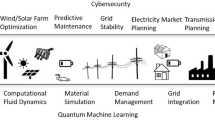Abstract
Environmental concerns have spurred greater reliance on variable renewable energy resources (VERs) in electric generation. Under current incentive schemes, the uncertainty and intermittency of these resources impose costs on the grid, which are typically socialized across the whole system, rather than born by their creators. We consider an institutional framework in which VERs face market imbalance prices, giving them an incentive to produce higher-value energy subject to less adverse uncertainty. In this setting, we consider an “aggregator” that owns the production rights to a VER’s output, and also signs contracts with a population of demand response (DR) participants for the right to curtail them in real time, according to a contractually specified probability distribution. The aggregator bids a day ahead offer into the wholesale market, and is able to offset imbalances between the cleared day-ahead bid and the realized VER production by curtailing DR participants’ consumption according to the signed contracts. We consider the optimization of the aggregator’s end-to-end problem: designing the menu of DR service contracts using contract theory, bidding into the wholesale market, and dispatching DR consistently with the contractual agreements. We do this in a setting in which wholesale market prices, VER output, and participant demand are all stochastic, and possibly correlated.





Similar content being viewed by others
Notes
Caramanis et al. (1983) categorized direct load control as “price/quantity transactions,” and price-based control as “price only transactions”.
The standard analysis ignores intertemporal interactions; but see, for example, Tsitsiklis and Xu (2015) for an extension to pricing for contribution to system-wide ramping cost.
But see Wilson (1993), who treats profit maximization but in a slightly different setting from ours.
However, Crampes and Léautier argue that the qualitative insights carry over to imperfectly competitive settings.
Our model implies that the aggregator offers a menu of quality-differentiated service options (Mussa and Rosen 1978) to each increment, independently of contracting with the rest. A consumer chooses a menu item for each of its increments, and its total utility and transfer are Lebesgue integrals over the corresponding utility and transfers for each increment. This treatment rules out quantity-based nonlinear price discrimination.
The EA subscript indicates that this objective is an expectation from the ex ante perspective.
We use the same symbols for random variables and their realized values.
In this case (let us still assume \(0< p < b\)), we would allow the curtailment of the VER if technologically feasible, represented by replacing the wind outcome s with a policy variable that is a truncation of s, \(\tilde{s} \le s\). Whenever \(a < 0\), it is clear that the aggregator would set \( DR + \tilde{s} \le q\). In cases of overproduction, the aggregator would reduce \( DR \) until \( DR \le q - s\) if possible, maintaining \(\tilde{s} = s\). But if this is not sufficient, because \(q - s < 0\), then at the optimum, \( DR = 0\) and \(\tilde{s} = q < s\). This is because \( DR \) is nonnegative and costly to produce (the aggregator dispatches DR by purchasing consumption options), and wind has zero operating cost. (We ignore the possibility of renewable production subsidies, as discussed in the introduction.) The general first-order conditions introduced up through Sect. 3.2 continue to hold with the minor technical adjustments, since \(a<0\) only makes the aggregator’s objective “more concave.” We exclude cases where \(a < 0\) in the analytical example of Sect. 3.3 for simplicity, since the solution presented there in Table 1 already comprises a profusion of cases.
We assume that this process is jointly measurable with respect to the product measure induced by g and the probability measure over \(\theta _\tau \). Therefore the process admits an essentially unique decomposition into an idiosyncratic component and an aggregate component (Al-Najjar 1995). We are not particularly interested in technical issues regarding measurability. Instead we simply posit, as suggested in Judd (1985), that the idiosyncratic noise obeys an exact strong law of large numbers. In a similar spirit, we make whatever assumptions necessary to license the application of Fubini’s theorem to exchange the order of integration with respect to g and expectation over the process \(\theta _\tau \), which should not be demanding, since each valuation takes a value in a compact interval \([{\underline{\theta }}, \overline{\theta }] \subset \mathbb {R}\). Further, the increments’ decision that is contingent on this information process involves no strategic interaction, so most of the potential technical complications do not arise.
This is a slight simplification: the collection of any penalties from increments, for violating curtailment signals, is also netted out from T ex post.
In our example in Sect. 3.3, the DA forecasts of imbalance prices are assumed to be perfect, so they are effectively revealed in this stage as well.
The product notation “\(\times \)” denotes concatenation of ordered tuples.
See Börgers (2010, Chap. 5.6).
This could easily be generalized, but assuming a very high density over a short interval of types should be a reasonable approximation to a point mass on a single type, and this setup allows us to distinguish increments anonymously—i.e. only by type—which is convenient.
See Börgers (2010, Chap. 5.6).
This “staticness” holds in a more specific sense than the more general result that sequential mechanisms can be reduced to a particular kind of static mechanism (Krähmer and Strausz 2015). This reflects our concrete interest in demand response as embedded in our end-to-end problem.
We just mean that there are some units of demand whose valuation for power is high enough that they would not accept a reasonable payment curtailment in any contingency. For example, hospitals with life support units may have some quantity level at which their demand is, for all intents and purposes, perfectly inelastic.
Here we closely follow the development of Börgers (2010, Chap. 2).
We should note, however, that the Revelation Principle assumes away problems of multiple equilibria. However, this is not a problem for us, because we have already restricted the curtailment policy set in Assumption 2.
See the discussion at the end of Börgers (2010, Chap. 2.2).
It turns out that this formula holds for general \(k(\cdot ,\cdot )\) satisfying incentive compatibility (i.e. we would integrate the above expression over the whole population, multiplying the integrand by k), not just for the cutoff form \(\hat{\tau }\), but this is not an immediate concern of ours here, so we leave this result unproved.
We assume that \(\psi \) is monotonically increasing in this representation, as we also do below when we solve the end-to-end problem.
We will argue in a followup work that the cost c should typically be monotonic. Another setting perhaps worth considering is for c “single-troughed,” i.e. quasi-convex, so that \(-c\) is single-peaked. This might obtain if it is prohibitively expensive to obtain DR from types low valuation types, because their yield is too low. We may consider the optimality conditions for this case elsewhere.
If c is weakly increasing, then the equality is replaced with \(\in \), and \(c^{-1}\) is interpreted as the set-valued preimage function.
The derivation of model parameters from elasticity estimates must be done before the change of variables, because an elasticity is a ratio involving the retail price, which we are eliminating from the problem.
For example, d is the probability that wind is less than \(q - \nu b /2\), which would imply that the wind quantity plus the maximum economical amount of DR be less than the offer quantity q.
Note that \(\nu = N / (\overline{s} ({\overline{\tau }} - {\underline{\tau }})) = g(R) / \overline{s}\). The elasticity at the retail rate is \(\eta (R) \triangleq g(R) \frac{R}{N}\). The parameter chosen yield \(\nu = 1/100\).
We did this by analytically solving the aggregator’s problem pointwise over \(\varOmega _\text {DA}\), and then taking expectations of the quantities with respect to our market statistics.
Despite the fact that the DR policy is held at its optimal values, we cannot apply an envelope theorem, because there is a positive probability that the value function is not differentiable with respect to \(\hat{\tau }\) at \(\hat{\tau } = \hat{\tau }^*\) (in all \(\omega _\text {DA}\) events where there is zero imbalance at the optimum, the right derivative with respect to \(\hat{\tau }\) has an a coefficient, and the left derivative has a b coefficient).
References
Al-Najjar, N. I. (1995). Decomposition and characterization of risk with a continuum of random variables. Econometrica, 63(5), 1195–1224. doi:10.1111/1468-0262.00060.
Bitar, E., Poolla, K., Khargonekar, P., Rajagopal, R., Varaiya, P., & Wu, F. (2011). Selling random wind. In Proceedings of the Annual Hawaii International Conference on System Sciences, pp 1931–1937. doi:10.1109/HICSS.2012.523.
Bitar, E. Y., Rajagopal, R., Khargonekar, P. P., Poolla, K., & Varaiya, P. (2012). Bringing wind energy to market. IEEE Transactions on Power Systems, 27(3), 1225–1235. doi:10.1109/TPWRS.2012.2183395.
Borenstein, S. (2005). The long-run efficiency of real time electricity pricing. The Energy Journal, 26, 93–116. doi:10.5547/ISSN0195-6574-EJ-Vol26-No3-5.
Börgers, T. (2010). An introduction to the theory of mechanism design. Oxford: Oxford University Press. http://aida.econ.yale.edu/~dirkb/teach/521b-08-09/reading/2008-mechanismdesign.pdf.
Braithwait, S., Hansen, D., & Kirsch, L. (2006). Incentives and rate designs for efficiency and demand response. Lawrence Berkeley National Laboratory Collaborative Paper 60132 (March). http://smartgrid.lbl.gov/sites/all/files/60132.pdf.
Caramanis, M., Schweppe, F. D., & Tabors, R. D. (1983). Spot pricing and its relation to other load management methods. Technical report. MIT Energy Laboratory Report MIT-EL 83-001
Chao, H. P. (1983). Peak load pricing and capacity planning with demand and supply uncertainty. Bell Journal of Economics, 14(1), 179–190.
Chao, H. P. (2012). Competitive electricity markets with consumer subscription service in a smart grid. Journal of Regulatory Economics, 41, 155–180. doi:10.1007/s11149-011-9179-7.
Chao, H. P., & Wilson, R. (1987). Priority service: Pricing, investment, and market organization. The American Economic Review, 77(5), 899–916. http://www.jstor.org/stable/1810216.
Courty, P., & Li, H. (2000). Sequential screening. Review of Economic Studies, 67(4), 697–717. doi:10.1111/1467-937X.00150.
Crampes, C., & Léautier, T. O. (2015). Demand response in adjustment markets for electricity. Journal of Regulatory Economics, 48(2), 1–33. doi:10.1007/s11149-015-9284-0.
Holland, S. P., & Mansur, E. T. (2006). The short-run effects of time-varying prices in competitive electricity markets. The Energy Journal, 27, 127–155.
Judd, K. L. (1985). The law of large numbers with a continuum of IID random variables. Journal of Economic Theory, 35(1), 19–25. doi:10.1016/0022-0531(85)90059-6.
Krähmer, D., & Strausz, R. (2015). Sequential versus Static Screening: An equivalence result, 1–13.
Margellos, K., & Oren, S. (2015). Capacity controlled demand side management: A stochastic pricing analysis. IEEE Transactions on Power Systems 99, 1–12. doi:10.1109/TPWRS.2015.2406813. http://ieeexplore.ieee.org/lpdocs/epic03/wrapper.htm?arnumber=7061537.
MDPT Working Group. (2015). Report of the market design and platform technology working group. Technical report. http://newyorkrevworkinggroups.com/wp-content/uploads/MDPT-Report_150817_Final.pdf.
Milgrom, P., & Segal, I. (2002). Envelope theorems for arbitrary choice sets. Econometrica, 70(2), 583–601. doi:10.1111/1468-0262.00296.
Mussa, M., & Rosen, S. (1978). Monopoly and product quality. Journal of Economic Theory, 317, 301–317.
Oren, S. S. (2013). A historical perspective and business model for load response aggregation based on priority service. In 2013 46th Hawaii international conference on system sciences (HICSS), pp 2206–2214. doi:10.1109/HICSS.2013.39.
RLW Analytics. (2007). Deemed savings estimates for legacy air conditioning and water heating direct load control programs in PJM region. Technical report. Middletown: RLW Analytics.
Tan, C. W., & Varaiya, P. (1991). A model for pricing interruptible electric power service. Technical report. Berkeley: EECS Department University of California. http://www.eecs.berkeley.edu/Pubs/TechRpts/1991/1695.html.
Tan, C. W., & Varaiya, P. (1993). Interruptible electric power service contracts. Journal of Economic Dynamics and Control, 17, 495–517.
Tsitsiklis, J. N., & Xu, Y. (2015). Pricing of fluctuations in electricity markets. European Journal of Operational Research, 246(1), 199–208. doi:10.1016/j.ejor.2015.04.020. http://www.sciencedirect.com/science/article/pii/S0377221715003136. arXiv:1207.2848v1.
Varian, H. R. (1992). Microeconomic analysis (2nd ed.). New York: WW Norton.
Wilson, R. B. (1993). Nonlinear pricing. New York: Oxford University Press.
Acknowledgments
The authors thank Felipe Castro for his help with an earlier version of this project. They would also like to thank the anonymous referees, for their careful review and insightful comments. This work was supported by the Department of Energy, through a grant administered by the Center for Electric Reliability Technology Solutions (CERTS).
Author information
Authors and Affiliations
Corresponding author
Appendix: Proofs
Appendix: Proofs
Proof of Lemma 2.8
Assumption 1 ensures the conditions sufficient for this claim. Note that \(L(\cdot )\) is absolutely continuous, and differentiable except at two points. Further, recall that the support of \(F(\cdot \vert \tau , \omega )\) is constant. Therefore we can apply integration by parts, and the antiderivative term drops out:
The partial derivative in question is therefore
Each term in the integrand is uniformly bounded, which guarantees that this partial derivative is uniformly bounded, so that the function \(U(\tilde{\tau } \vert \cdot )\) is Lipschitz continuous, and thus absolutely continuous.
Proof of Proposition 2.10
By rearrangement, the payment is the equilibrium utility minus the net option value:
First we simplify the expression for \(u(\tau )\) from line (8). Under merit order curtailment, \(k(\tau ,\omega ) = \mathbbm {1}_{\{ \tau \le \hat{\tau }(\omega )\}}\). Exchanging the order of integration so that we integrate first with respect to \(\tau \), we get that:
Subtracting from this the net option value \(U(\tau )\), we arrive at the desired result.
Proof of Proposition 2.12
Consider the difference in utility between the case where an increment of ex ante type \(\tau \) reports truthfully, versus mis-reporting as \(\tilde{\tau }\).
Suppose \(\tau > \tilde{\tau }\). Merit order curtailment implies that \(k(\tau ,\omega ) - k(\tilde{\tau },\omega ) = - \mathbbm {1}_{\{\tilde{\tau } \le \hat{\tau }(\omega ) < \tau \}} \le 0\). On this set, FOSD implies that \(F(\theta \vert \tau , \omega ) \le F(\theta \vert \hat{\tau }(\omega ), \omega )\). This implies that the integral’s value is nonnegative. Similarly, if \(\tau < \tilde{\tau }\), then \(k(\tau ,\omega ) - k(\tilde{\tau },\omega ) = \mathbbm {1}_{\{\tau \le \hat{\tau }(\omega ) < \tilde{\tau } \}} \ge 0. \) On this set, \(F(\theta \vert \tau ,\omega ) \ge F(\theta \vert \hat{\tau }(\omega ), \omega )\). Again, the integral’s value is nonnegative. \(\square \)
Proof of Proposition 2.14
The substance of the Proposition is that (ignoring the penalty receipts term)
Integrating Eq. (9) under merit order curtailment, we get that
To obtain the desired formula, we first apply the fundamental rule of calculus to express the integrand as \(\int _{{\underline{\tau }}}^{\hat{\tau }(\omega _\text {RT})} z(\tau )G(\tau ) \mathrm{d}\tau \). in (35) differentiate the integrand in (35) using the product rule, factor out a “\(g(\tau )\),” and re-integrate.
Proof of Proposition 3.8
(FONC for \(q^*\) ) In order to differentiate this objective with respect to q, we decompose RT outcomes into three sets: overproduction = \(\{ DR + s > q\}\), shortfall = \(\{ DR + s < q \}\), and no imbalance = \(\{DR + s = q\}\).Footnote 29 From expression (15), we see that
Here we ignore certain “edge” events, which we assume have probability zero: abusing notation,
Also, note that the contributions to the expected derivative from the overproduction and shortfall terms are both zero when \( DR + s = q\), because by assumption, the shortfall quantity is constantly zero on this set. When overproduction and underproduction are strict, then \(\frac{\partial }{\partial q} \hat{\tau }^*(\omega _\text {RT} \vert q) =0\).
This gives us that
The first order condition follows. \(\square \)
Rights and permissions
About this article
Cite this article
Campaigne, C., Oren, S.S. Firming renewable power with demand response: an end-to-end aggregator business model. J Regul Econ 50, 1–37 (2016). https://doi.org/10.1007/s11149-016-9301-y
Published:
Issue Date:
DOI: https://doi.org/10.1007/s11149-016-9301-y
Keywords
- Electricity markets
- Demand response
- Aggregator
- Business model
- Renewables integration
- Market design
- Screening mechanisms




